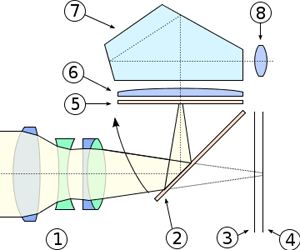A Photography is the art or process of producing images by the action of radiant energy and especially light on a sensitive surface…
What do DSLR cameras consist of?
Take a look at the following image of an SLR cross section (image courtesy of Wikipedia):

- Lens
- Reflex mirror
- Shutter
- Image sensor
- Matte focusing screen
- Condenser lens
- Pentaprism
- Eyepiece/Viewfinder
How do DSLR cameras work?
When you look through the viewfinder on the back of the camera, whatever you see is exactly what you are going to get in the photograph. The scene that you are taking a picture of passes through the lens in a form of light into a reflex mirror (#2) that sits at a 45 degree angle inside the camera chamber, which then forwards the light vertically to an optical element called a “pentaprism” (#7). The pentaprism then converts the vertical light to horizontal by redirecting the light through two separate mirrors, right into the viewfinder (#8).
When you take a picture, the reflex mirror (#2) swings upwards, blocking the vertical pathway and letting the light directly through. Then, the shutter (#3) opens up and the light reaches the image sensor (#4). The shutter (#3) remains open for as long as needed for the image sensor (#4) to record the image, then the shutter (#3) closes and the reflex mirror (#2) drops back to the 45 degree angle to continue redirecting the light into the viewfinder.
Obviously, the process doesn’t stop there. Next, a lot of complicated image processing happens on the camera. The camera processor takes the information from the image sensor, converts it into an appropriate format, then writes it into a memory card. The whole process takes very little time and some professional DSLRs can do this 11 times in one second!



